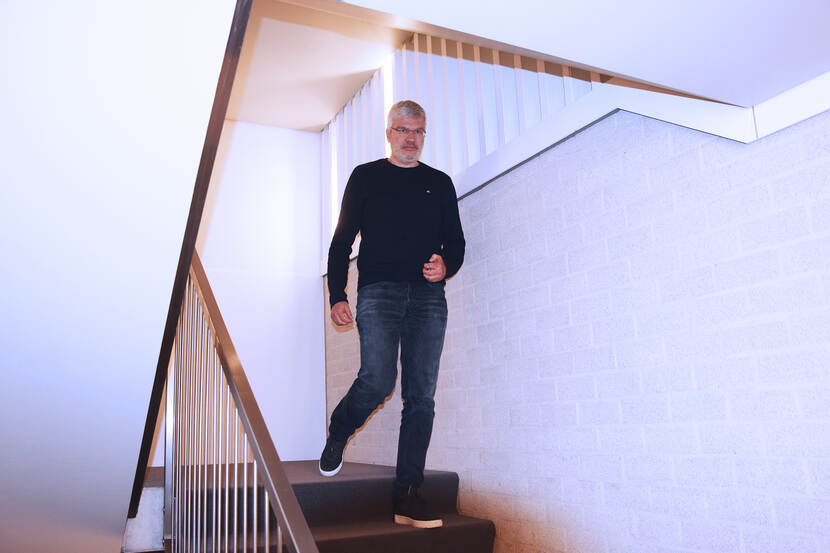The NFI studies the reliability of building level (floor) registration in iPhones for crime reconstruction purposes
A deadly stabbing incident on the third floor of an enclosed flat building in The Hague. And a suspect denying any and all involvement. To determine whether the suspect’s presence at the crime scene can be established, the police examined the digital traces on his telephone. This proved successful up to the front door of the flat building in question, using location tracking and the step counter. But not inside, on the third floor. The reason was that his telephone only registered two floors. The police then contacted the Netherlands Forensic Institute (NFI): how reliable is the registration of building levels on an iPhone really? NFI specialists conducted extensive tests. ‘This research is useful in crime reconstructions.’

NFI scientist Jan Peter van Zandwijk and a student at Amsterdam University of Applied Sciences did experiments to test the reliability of building level registration. Close to home, on the NFI’s premises. ‘We did tests with different iPhone models. We had several testers walk up and down stairs multiple times. Sometimes they walked up one staircase, sometimes three, then one down, in a variety of sequences and at different speeds. The testers also wore the phone in different places every time’, explains Van Zandwijk.
Three metres
The scientist conducted the experiments to gain insight into the factors that impact the accuracy of the registration in order to make a well-founded statement as to reliability. The iPhone’s health app states that an elevation of approximately 3 metres is registered as one floor or building level. The NFI research demonstrates a vital precondition: you must be walking at the same time, as the phone does not register floors/building levels when you are not walking. ‘When you gain altitude in a lift, the app does not register floors’, explains Van Zandwijk. ‘Nor does it when you are standing still on an escalator, but it does register the floors when you are walking on an escalator.’
The NFI research shows that an iPhone does indeed register roughly every 3 metres of altitude difference as a floor. It does not count physical building levels, in other words. ‘We measured the height of the floors at the NFI. In our research, we noticed that the number of floors registered by the telephone most frequently coincides with the number of 3-metre blocks that a tester walks up or down one or more floors. If the elevation varies less than 3 metres, registration is less reliable. We saw that the app sometimes does and at others does not register a floor if the elevation is 2.4 metres. So the result depends on the specific situation.’
The researcher also discovered that the health app only registers floors when you walk upstairs. However, there is also a different interesting technical file on the iPhone that contains temporary information about stairs walked both up and down. This file is not visible to the user but can be retrieved from a telephone using forensic software.
Research at the crime scene
In addition to the reference research at the NFI, the investigators did additional research at the crime scene, inside the building where the deadly stabbing incident occurred. ‘We measured and tested everything there, too. We examined what the iPhone registers in terms of floors in the scenario where you walk from the ground floor to the third floor or a different floor.’ Van Zandwijk explains that looking at the number of metres of elevation, the registration of two floors in the suspect’s phone matches the scenario in which he walked from the ground floor to the third floor. This is because the third floor was about 7 metres up, i.e. two 3-metre blocks and another 1 metre. ‘We know that the app counts every 3 metres as one floor. As such, the number of physical floors does not have to match the number of floors registered by the phone.’
Other cases
The NFI’s study on the reliability of building level registration helps the police in crime reconstructions. What did a person do in a specific timeframe? Did they walk upstairs or did they only walk on flat surfaces? Even if a suspect offers an alternative scenario of what may have happened, you can now verify this in a well-founded manner. ‘This research question came up in this specific case but the findings may certainly prove useful in other cases where it is uncertain whether a person was present on a specific building level.’
Bigger project
This study is part of a bigger project in which the NFI examines the relationship between actions in the physical world and digital traces. Internationally speaking, such research is relatively new. Prior to this, NFI specialists studied the reliability of step and distance registration of the iPhone health app.
A scientific publication on this research will be published in the near future.